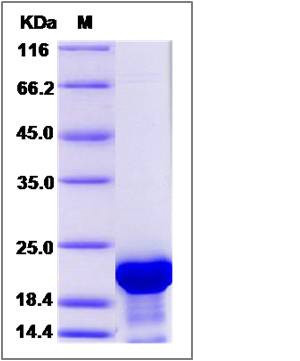Human TPPP3 Protein (His Tag)
CGI-38,p20,p25gamma,TPPP/p20,TPPP3
- 100ug (NPP2554) Please inquiry
| Catalog Number | P14360-H07E |
|---|---|
| Organism Species | Human |
| Host | E. coli |
| Synonyms | CGI-38,p20,p25gamma,TPPP/p20,TPPP3 |
| Molecular Weight | The recombinant human TPPP3 consists of 191 amino acids and predicts a molecular mass of 20.8 KDa. It migrates as an approximately 21 KDa band in SDS-PAGE under reducing conditions. |
| predicted N | His |
| SDS-PAGE |  |
| Purity | > 85 % as determined by SDS-PAGE |
| Protein Construction | A DNA sequence encoding the mature form of human TPPP3 (Q9BW30) (Met1-Lys176) was expressed with a polyhistide tag at the N-terminus. |
| Bio-activity | |
| Research Area | Immunology |Signal Transduction |Cytoskeleton / ECM |Cytoskeletal Proteins |Microtubules |Tubulin | |
| Formulation | Lyophilized from sterile PBS, pH 7.4 1. Normally 5 % - 8 % trehalose and mannitol are added as protectants before lyophilization. Specific concentrations are included in the hardcopy of COA. |
| Background | TPPP3, a member of the Tubulin polymerization-promoting protein family, is an intrinsically unstructured protein that induces tubulin polymerization. TPPP3 is a marker in the developing musculoskeletal system. In tendons, Tppp3 is expressed in cells at the circumference of the developing tendons, likely the progenitors of connective tissues that surround tendons: the tendon sheath, epitenon, and paratenon. Tppp3 is also expressed in forming synovial joints. The onset of Tppp3 expression in joints coincides with cavitation, representing a molecular marker that can be used to indicate this stage in joint transition in joint differentiation. In late embryonic stages, Tppp3 expression highlights other demarcation lines that surround differentiating tissues in the forelimb. |
| Reference |
